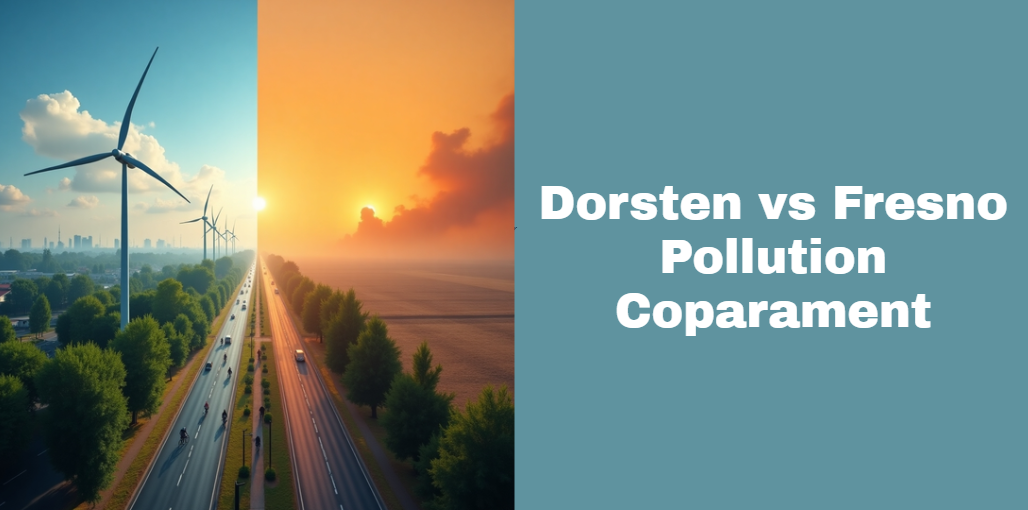Dorsten vs Fresno Pollution Coparament: A Detailed Comparison of Air Quality, Health Impact and Environmental Efforts
Air pollution is one of the most pressing global environmental challenges, affecting public health and the ecosystem alike. Comparing two cities from different parts of the world can offer valuable insights into the causes and effects of pollution and the strategies used to combat it.
This article focuses on the dorsten vs fresno pollution coparament, analyzing the air quality, pollution sources, health outcomes, and environmental policies in these two cities. Dorsten is a relatively small city in Germany, while Fresno is a large urban center in California, USA. Despite their differences in geography and size, both cities face pollution issues—albeit at different scales and from varying sources.
Geographic and Climatic Context
Dorsten
Dorsten is situated in the state of North Rhine-Westphalia, Germany. It enjoys a temperate maritime climate characterized by moderate temperatures and regular precipitation throughout the year. The city is surrounded by greenery and farmland, with some nearby industrial zones contributing to localized air quality concerns.
Dorsten’s position in Europe means it benefits from stringent EU environmental standards and frequent air quality monitoring.
Fresno
Fresno, located in the heart of California’s Central Valley, has a semi-arid climate. Summers are long, hot, and dry, while winters are mild and short. The surrounding mountains trap air pollutants, leading to frequent smog accumulation.
This geography, combined with agricultural and industrial activities, significantly contributes to Fresno’s air pollution levels.
Air Quality Overview
The Air Quality Index (AQI) is a standardized measurement of air pollution levels. A lower AQI indicates better air quality, while higher values suggest a greater health risk. Here’s a comparison of AQI values between Dorsten and Fresno:
| City | Average AQI | Air Quality Rating |
|---|---|---|
| Dorsten | 30 – 50 | Good |
| Fresno | 100 – 150 | Unhealthy for Sensitive Groups |
In the dorsten vs fresno pollution coparament, Dorsten clearly has better overall air quality. While Dorsten’s AQI remains within the “Good” category most of the year, Fresno frequently experiences AQI values that are considered unhealthy, especially for children, elderly, and individuals with respiratory conditions.
]Primary Sources of Pollution
Pollution sources differ significantly between Dorsten and Fresno due to differences in industrial activities, transportation, and land use.
Dorsten
- Traffic Emissions – Diesel-powered vehicles contribute to nitrogen dioxide (NO₂) levels.
- Agricultural Runoff and Dust – Farming activities release ammonia and fine particulate matter.
- Heating Systems – Use of solid fuels in older residential areas contributes to winter smog.
Fresno
- Agriculture – One of the largest contributors, releasing ammonia, dust, and pesticides.
- Vehicle Emissions – Urban traffic and highway proximity add to NO₂ and carbon monoxide levels.
- Wildfires – Seasonal fires dramatically increase PM2.5 and PM10 concentrations.
- Industrial Operations – Emissions from manufacturing and energy production facilities.
These varied pollution sources help explain the differences observed in the dorsten vs fresno pollution coparament.
Key Pollutants and Their Levels
Let’s compare the major air pollutants found in both cities:
| Pollutant | Dorsten (Avg Level) | Fresno (Avg Level) | Safe Limit (WHO) |
|---|---|---|---|
| PM2.5 | 10-12 µg/m³ | 35-50 µg/m³ | 10 µg/m³ |
| PM10 | 20-30 µg/m³ | 50-70 µg/m³ | 20 µg/m³ |
| NO₂ | 20-25 µg/m³ | 15-20 µg/m³ | 40 µg/m³ |
| O₃ (Ozone) | 30-40 ppb | 70-90 ppb | 50 ppb |
While Dorsten occasionally exceeds PM10 limits during winter, Fresno consistently surpasses WHO guidelines, particularly for PM2.5 and ozone—making it one of the most polluted urban areas in the U.S. This sharp contrast is a major point in the dorsten vs fresno pollution coparament.
Health Impacts
Air pollution has direct and indirect effects on human health. These effects are more pronounced in populations exposed to poor air quality over long periods.
In Dorsten
Residents generally enjoy clean air, which means fewer pollution-related health issues. However, during colder months, an increase in particulate matter from residential heating can cause:
- Minor respiratory discomfort
- Aggravation of asthma symptoms
- Occasional cardiovascular stress in elderly individuals
In Fresno
The situation is far more severe. The high levels of ozone and PM2.5 are linked to:
- Increased asthma rates in children
- Chronic obstructive pulmonary disease (COPD)
- Heart attacks and strokes
- Higher incidences of cancer from prolonged exposure
Public health studies have found that residents of Fresno have a significantly higher hospitalization rate due to respiratory problems compared to the national average.
Environmental Policies and Regulations
Dorsten’s Approach
Being part of the European Union, Dorsten follows strict environmental laws. The city actively promotes:
- Green energy usage
- Low-emission zones
- Public transportation improvements
- Monitoring and enforcement of emission limits
Fresno’s Approach
California is known for progressive environmental policies, but enforcement varies due to economic and logistical constraints. Measures include:
- Air quality control boards
- Incentives for electric vehicles
- Fire management and prevention strategies
- Regulations on agriculture and industry
Despite these efforts, Fresno continues to struggle with air quality due to its geographical and economic challenges.
Mitigation and Improvement Efforts
Both cities have invested in pollution control strategies, but with different levels of success.
Dorsten
- Increased tree planting and urban green spaces
- Expansion of bike lanes and pedestrian zones
- Retrofitting old buildings with cleaner heating systems
Fresno
- Introduction of air filters in schools and public buildings
- Reforestation projects to restore wildfire-damaged areas
- Support for renewable energy farms in rural parts of the county
The dorsten vs fresno pollution coparament clearly shows that while Dorsten’s measures have led to a noticeable improvement in air quality, Fresno’s efforts are often offset by natural and systemic issues like wildfires and valley geography.
Comparative Analysis
Let’s summarize the core findings in a comparative table:
| Factor | Dorsten | Fresno |
|---|---|---|
| Average AQI | 30-50 (Good) | 100-150 (Unhealthy) |
| Main Pollution Source | Traffic & agriculture | Agriculture, vehicles, fires |
| Major Health Impact | Mild respiratory issues | Severe respiratory diseases |
| Environmental Regulation | Strict EU laws | Progressive, but challenged |
| Air Quality Improvement | Consistent | Inconsistent due to wildfires |
This comparative overview helps highlight the stark environmental and health differences in the dorsten vs fresno pollution coparament.
Conclusion
The pollution comparison between Dorsten and Fresno reveals a wide gap in air quality, sources of pollution, and health impacts. Dorsten benefits from strong regulatory frameworks, moderate climate, and consistent urban planning. Fresno, on the other hand, faces severe challenges due to its geographical location, wildfire risks, and industrial-scale agriculture.
Understanding these contrasts can help policymakers, researchers, and citizens make informed decisions. Whether it’s investing in green infrastructure or enforcing stricter emission limits, there are lessons to be learned on both sides of the dorsten vs fresno pollution coparament.
Recommended Articles
KidsTurnCentral.com: A Complete Guide to a Family-Friendly Online Resource
What Answers to Pick to Get Ciel Phantomhive in Quizkie: Ultimate Guide for Anime Quiz Lovers
Unlocking Professional Writing Excellence with www.urbanwritingpros.com: Complete Service Overview






